Onsite and offsite SEO, otherwise known as on-page and off-page SEO, are the two main components of the search engine optimization (SEO) process. For maximum exposure to the search engine results and for higher rankings, you need to understand the difference between the two and how to utilize them better.
What is onsite SEO?
Onsite SEO is the process of making your website search engine friendly.
In simple words, this means adjusting certain elements on your website so that search engines are able to crawl and understand the content and structure of your website.
The more information and data they can get from your site, the greater are your chances of ranking higher in their index.
Working and fixing potential problems related to on-page SEO is the first step you should take when optimizing your website for search engines and in particular Google.
Most important onsite SEO elements
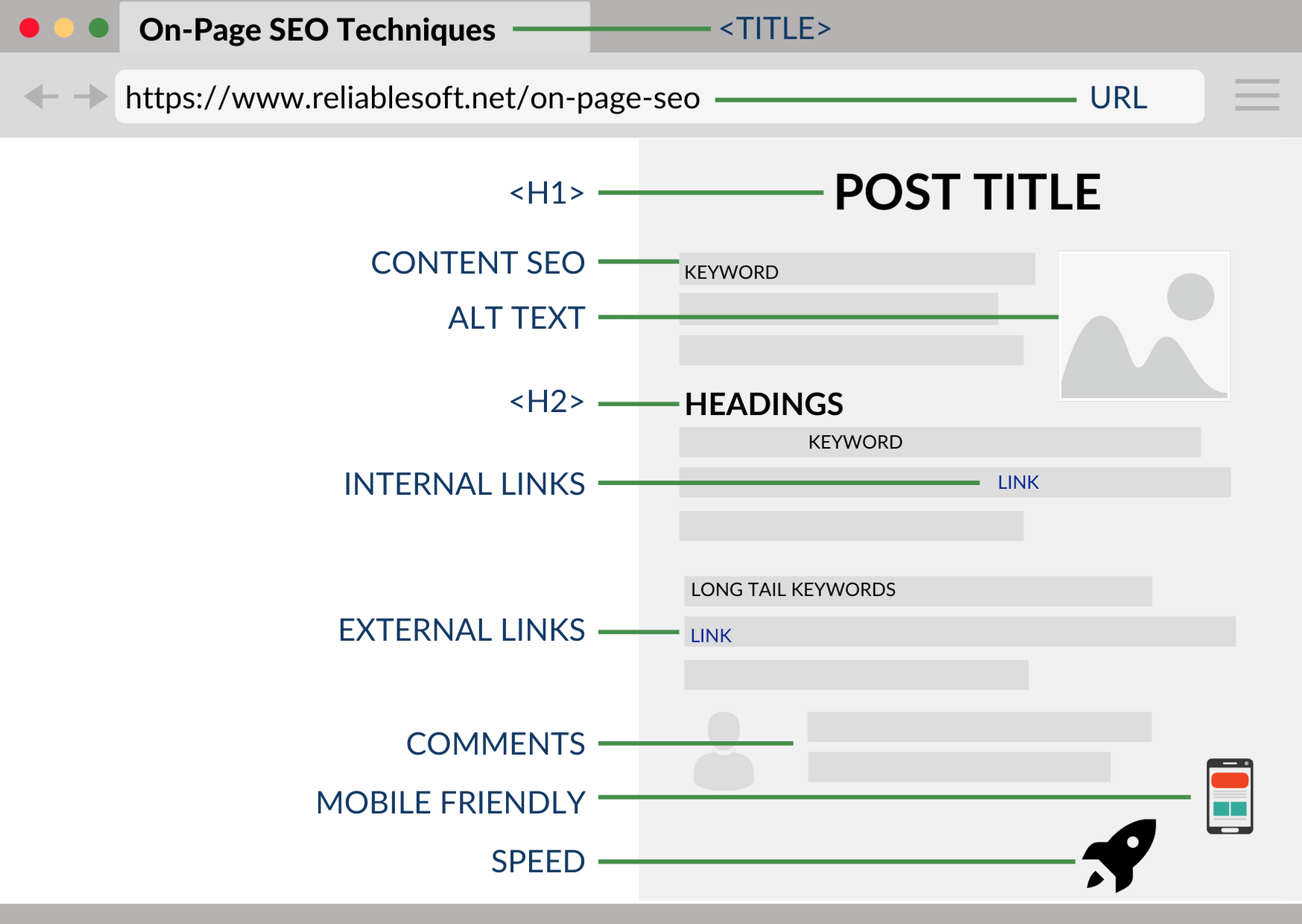
Onsite SEO is not hard to get right. There are a number of things you can check and fix and a few mistakes to avoid to ensure that everything is set up in the way it should be.
The most important on-page SEO elements are:
Your page titles and descriptions
If you are into SEO, you must have read this a million times and this is because it is one of the most important SEO factors.
The page title and description are what the search engines ‘read’ first when crawling a page.
If your titles and descriptions are not optimized in the way search engine crawlers want, you are making their task more difficult and this is not working in your favor.
How do you optimize your titles and descriptions?
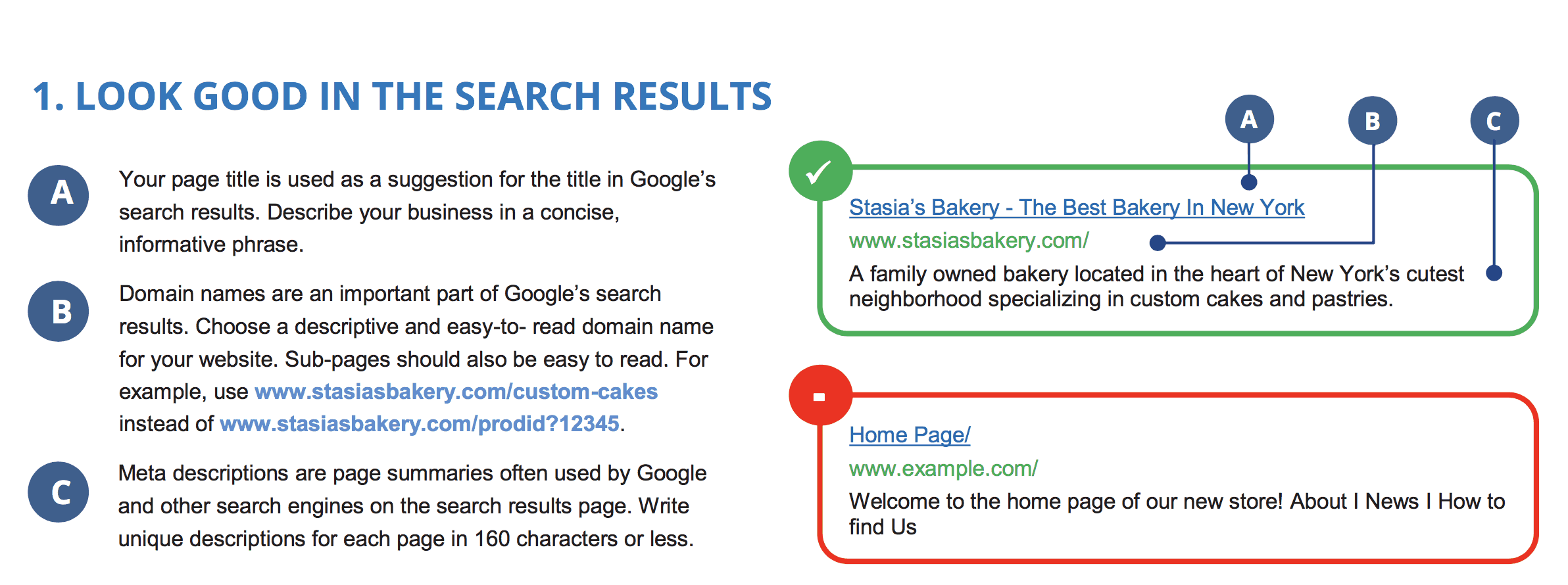
The rules are simple:
- Keep the title close to 60 characters and the description to no more than 150 characters.
- Avoid keyword stuffing i.e. adding keywords in the titles or descriptions that don’t make sense, but do try to give search engines and users a good idea on what the page is about.
A good approach when optimizing these is to come up with titles and descriptions that are catchy and encourage users to click but at the same time making sure that they are related to what people may search (that is relevant to the content of the page).
There are many tools to help you optimize your titles, I use semrush most of the times and the process is the following:
- Think of search terms users may use to find your page
- Pass those queries through Google, Semrush, google keyword tool to find out the search volume, keyword difficulty and what others are using as titles for those queries.
- Identify which keywords (preferably long-tail keywords) are appropriate for your page
- Try to include those keywords in your titles while at the same time giving the title a friendlier and interesting tone.
For example:
Search Phrase: ‘benefits of bananas’
Keyword (after research): ‘banana health benefits’
Title: ‘10 Amazing health benefits from eating bananas daily’
Description: ‘Eating bananas on a daily basis offers a number of health benefits. Number 3 is amazing and will definitely surprise you! Read on to find out how.’
The H1 Tag
A well-optimized page should have only one H1 tag and several h2,h3 tags. The h1 tag is usually the same as the page title (although it doesn’t have to be exactly the same).
A quick way to find out if your page follows this rule is to right-click anywhere on your page and select VIEW SOURCE from the pop-up menu.
Then click CTRL-F to open the ‘Find’ box and search for H1. if you see more than two instances of <h1> and </h1> then ask your developer to fix it so that the page has only one H1 tag.
ALT text for images
If you use images within your text (and you should), you need to make sure that the ALT text has a meaningful value that will give a good indication to search engines about the content of the image and how this is related to your page.
For example for the image below, I have set the ALT text to ‘onsite SEO principles’.
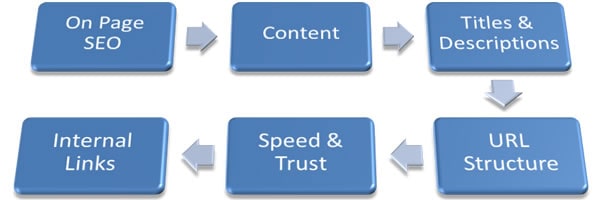
Internal links
I am perhaps the biggest fan of internal links and this is because:
- They enhance the user experience
- They are ‘safe’ to use
- They help search engines discover more pages from your website
- They help you create content that is strongly inter-related
- They reduce a website’s bounce rate
- They help you ‘lead’ readers to the most important pages of your website.
Read my post on internal linking best practices for more details but as a rule of thumb, when you do your onsite SEO review, make sure that your pages have internal links that are useful for the users to see and click.
Accessibility
None of the above techniques would be useful if search engines cannot access your website.
This is SEO 101 but you need to make sure that you are not accidentally blocking crawlers from accessing your pages.

The best way to find out if you have an issue with accessibility is to register your website with Google search console and run the ‘URL INSPECTION’ tool.
By doing this test, Google will tell you if there is something that prevents them from indexing your website properly.
In addition, you can make use of other Google search console reports to find and fix crawl errors.
Content
I cannot stress enough the importance of high quality, interesting and unique content in the whole SEO process.
If you don’t have content that has these characteristics there is no point in dealing with on-page or off-page SEO.
I will not go into many details here about content, you can read my post about evergreen content to learn how to craft content that ranks well and also this post which explains how long to make your articles.
What you need to have always in mind when working with websites and digital marketing is that content always has to come first and then everything else.
Other onsite SEO factors:
Besides the above, other SEO factors to consider when doing onsite optimization are:
- Well formatted URLs (words separated by ‘-’)
- Proper use of breadcrumbs
- Use of structured data
- Website Speed
- Mobile-friendliness
- Transparency (who wrote the post)
- Broken links
- Properly configured 404 pages
For a full list of SEO factors, take a look at my SEO Checklist.
What is offsite SEO?
I have spent more time discussing onsite SEO since I consider this to be the first step you need to take before even thinking about offsite SEO.
Nevertheless, off-page SEO is equally important and necessary.
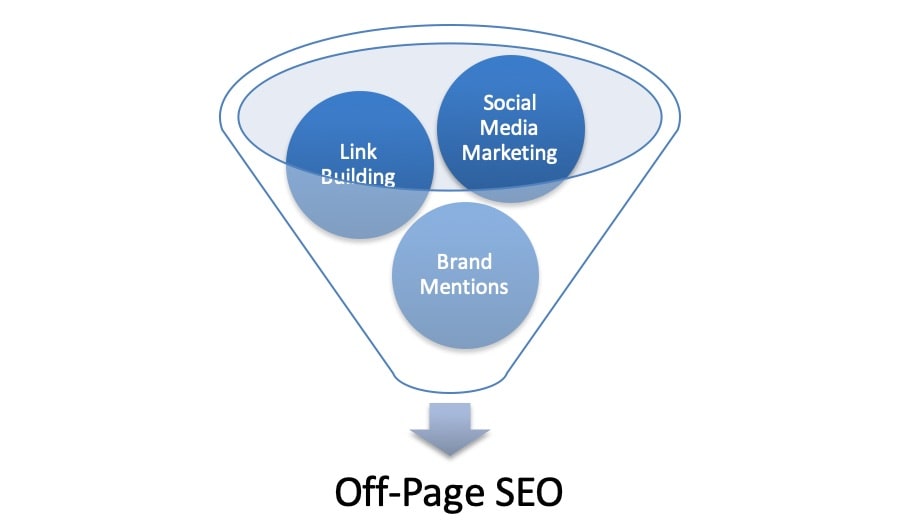
Off-Site SEO refers to actions you can take to promote your website on the web (besides advertising).
The most commonly used methods are:
- Links pointing to your website from other websites.
- Social media marketing.
Link Building
When a user is typing a query in the search box (of search engines), they have to decide which websites to show in the first positions of the SERPS and the order they will show them.
To be able to do that in a way that will keep their users happy about the results, they use a number of factors (Google is using more than 255 SEO ranking factors) in their ranking algorithms.
The algorithms are influenced (either positively or negatively) from links pointing to a website.
If the links are coming from trusted and related websites, they are considered as a ‘vote of trust’ and they can help a website rank higher.
If on the other hand if they are coming from low-quality websites, they can lower the rankings of the particular website or even get it into trouble (think Google penalties).
Over the years there has been a lot of discussion in the SEO community about natural vs unnatural links, practices that are ‘allowed’ and practices that are considered as black hat but many people still have questions on how to approach this process.
To understand how to use link building correctly, you need to know what Google is saying about links.
In summary, Google considers any type of link that was generated for the intention of manipulating its algorithm as unnatural.
A lot of unnatural links will eventually lead to a penalty.
This means that you should not buy, sell, exchange or ask for links for the purpose of increasing your rankings.
What can you safely do?
Don’t get into the habit of building links (especially from low-quality sites) but go after natural links.
Natural links are given to you by other websites because they found your content and website interesting and worth linking.
This may sound weird but it does work much better than spending time and effort to build links that may get you into trouble.
Read how my blog traffic increased to 400K per month without doing any link building; this is just one of the examples I can share of my own websites or client websites that rank high and get a lot of Google traffic without doing any sort of link building.
You do need links, don’t get me wrong, but you can get them naturally if you have good content and if you can successfully put your content in front of many people.
What is the best way to do this?
Through content marketing, solid promotion tactics, careful guest posting, and social media marketing.
Content marketing can help you publish the right content and good promotion techniques can get your content in front of the right people.
Guest posting on sites that matter and have a high Google trust can give you more benefits than building tens of low-quality links.
Social Media Marketing
Social media marketing is the fastest way to promote your content to people that may show an interest. It’s not always easy to do, you need a plan and you may have to spend some money but it works and it is safe and solid.
I will explain in more details in an upcoming article how to get natural links using the above methods, for the purpose of this post it is important to understand how off-page SEO works and the difference it has with onsite SEO.
Onsite VS Offsite SEO. Which one do you need?
As explained above you need both. Your first concern is to get your on-page SEO correct so that search engines can understand your content.
Then, once you have enough quality content published on your website you can start thinking about off-page SEO and how to get strong natural links from other websites that will further boost your rankings.
Don’t start the other way around. If a website doesn’t have all those characteristics to be considered a great website, then it’s not a good candidate for natural links.
And this is another signal to Google that any links pointing to the site are the result of practices that violate their guidelines.
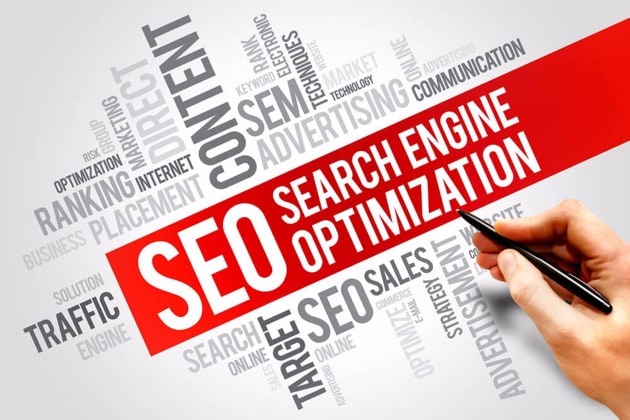




Hi Alex. There are two things I want to ask of you.
1. I wrote my content without using any keyword. My site title, content title, and the description in the first paragraph, everything is unmatched. So it’s hard to get page ranking. I want to refine my content by stuffing some (key)words in it. But I have submitted all my content to Google webmaster tools a month ago. What should I do?
2. I can’t afford keyword tools because they are pricey and I don’t understand how to use Google adwords. Is there any other way to search for some good keywords that I can use for my site content?
Thank you,
Tippi.
Hi Tippi,
Thanks for your comment.
1) That’s not a problem, make the changes you want and Google will pick them up. You can even use the FETCH AS GOOGLE and then SUBMIT TO INDEX option in webmaster tools to let Google know that you made changes.
2) The best free tool is the Google keyword tool – http://www.google.com/sktool – you don’t need to learn how to use adwords to use the tool, you only need an adwords account to access the tool. Read this for some examples: https://www.reliablesoft.net/what-should-i-write-in-my-blog-and-how-to-choose-post-titles/
Hope this helps
Alex
Great article. I just learned the basics about the different types of SEO strategies. I can now move on to research more about it and improve the knowledge I need to start providing these services to my clients. I appreciate. Is there anything else you recommend me doing?
Hi Marcus
Thanks for your comment. The best way to approach SEO learning is to start with the basics and then gradually move on to the more advanced topics. This Guide will help: https://www.reliablesoft.net/seo-basics-guide/
Thanks
Alex
Great article and well articulated! I have learnt lot of basics and applied soon will start some adv tricks. Thanks Alex
Hi Darpan
Thanks a lot for comment.
All the best,
Alex
The most important thing in SEO is the increase in organic visitors. Keyword handling helps the site appear on the first page of the Google, and so increase attendance, but the most important thing is to enter more users. And the quality of the service or the goods will determine if they will buy.
Hi Panagiotis
That’s correct, the main goal of SEO is to increase organic visitors and keywords play a vital role in the whole process.
All the best
Alex
Thanks for your comment. The best way to approach SEO learning is to start with the basics and then gradually move on to the more advanced topics. This Guide.Great article. I just learned the basics about the different types of SEO strategies. I appreciate.